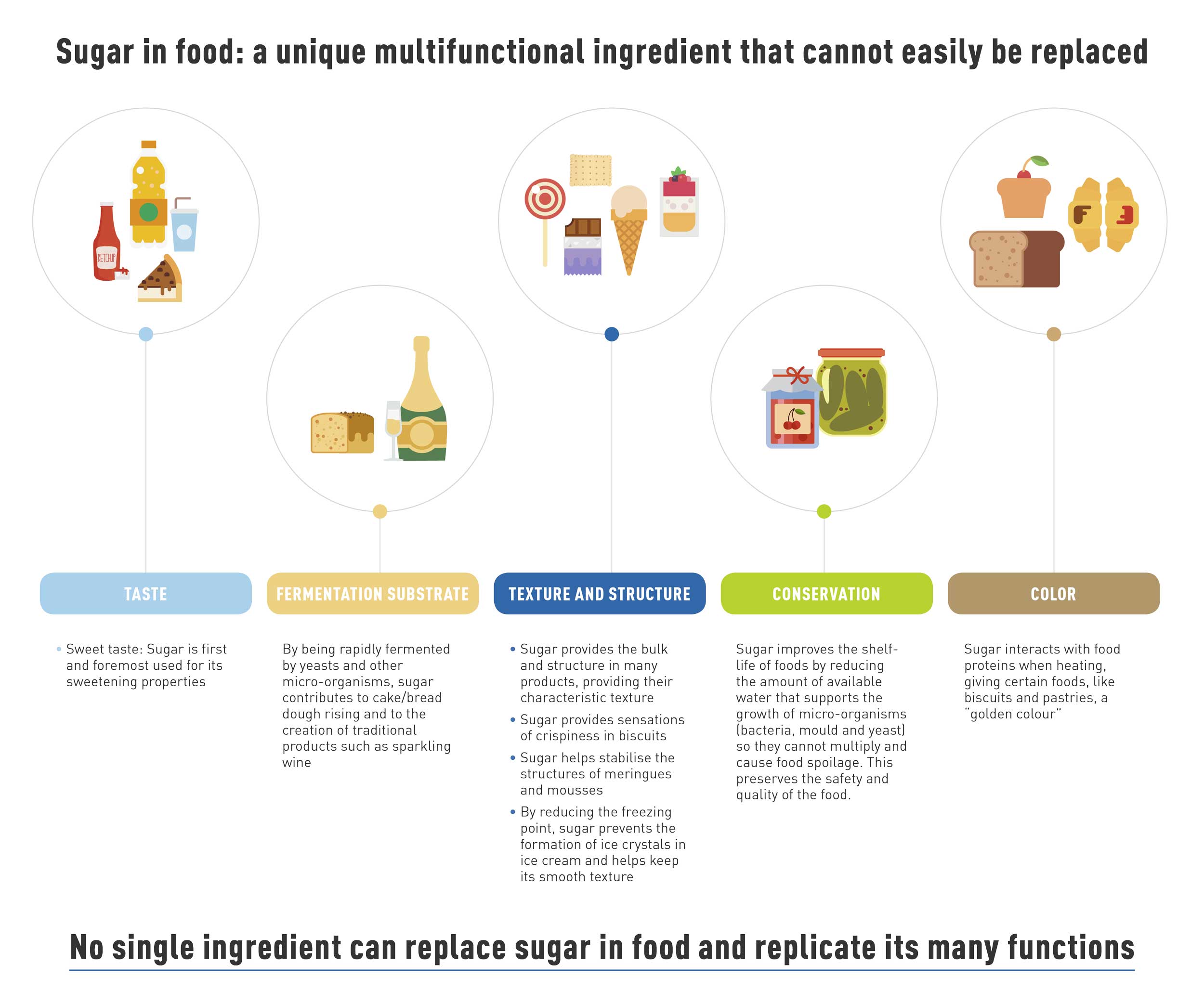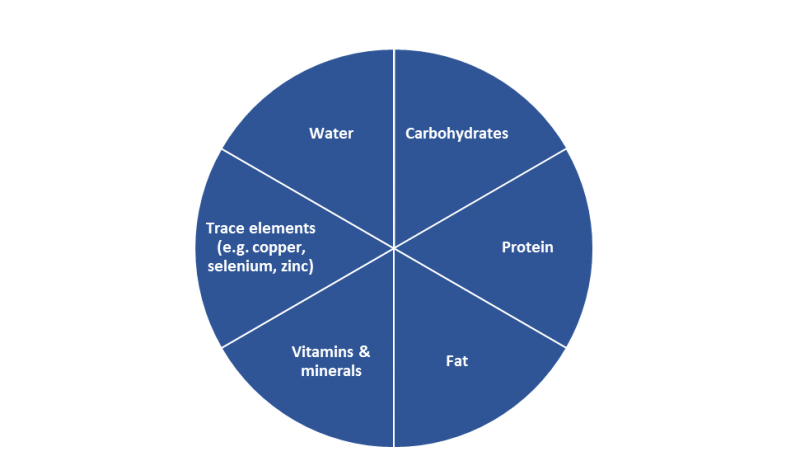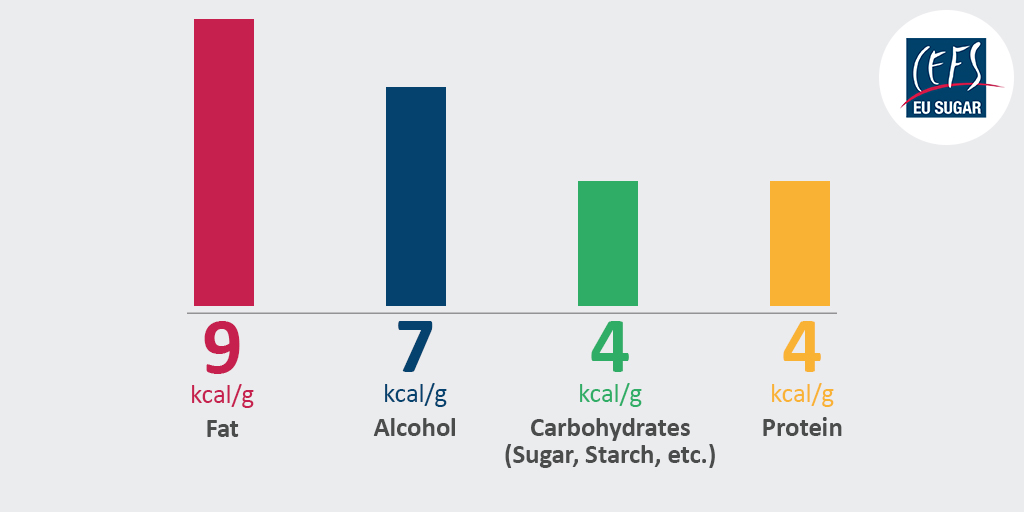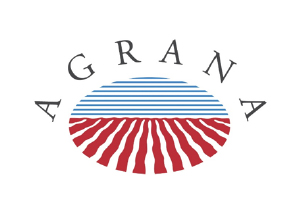Sugar is a carbohydrate. Carbohydrates are the most important fuel for our brains and provide our bodies with the energy our organs need to function.
Sugars are present in nature; plants make sugars through photosynthesis. The sugar (sucrose) you find in your sugar bowl is simply water-extracted from beet or cane by sugar producers. Sucrose found in a fruit and sucrose used to bake a cake are identical. All have the same calorific values (4 kcal/ 17 kJ of energy per gram). The body does not distinguish between sugars used in manufactured food and drinks or in the home, and those found naturally in foods.
To function correctly, our body needs:
There are many different types of sugars. They all provide 4 kcal/17 kJ per gram. The sugars most commonly present in foods include: sucrose, glucose, fructose, maltose and lactose. All of these sugars occur naturally.
- Sucrose is simply table sugar.
- Glucose, fructose and sucrose are found in honey, and fruit and vegetables (see table below).
- Maltose is a sugar produced by starch breakdown and is found in germinating cereals such as barley
- Lactose is found in milk and milk products
Examples of sources of sugars in various fruits, vegetable and honey:[1]
Sugar is first and foremost used because of its sweetening properties. It has a clean sweet taste with no aftertaste and is the reference against which other sweeteners are compared. Beyond its sweetening properties, sugar provides structure and texture to many traditional foods, such as bakery products and jam. Sugar helps to create crispness and texture in biscuits, and is central to the browning process that gives bread and pastries their traditional golden colour and characteristic flavour.
In some products, sugar can act as a natural preservative. Reducing sugar concentration in a food product may shorten its shelf life and impact on quality. For example, a jam with reduced sugars content will need to be stored in the fridge.
No single ingredient can replace sugar in all foods and replicate its many functions at the same time. Thus, replacing sugar often results in the use of several additional ingredients and additives, which may result in higher calorie content.

There is a common misperception that sugar consumption has risen over the years. However, the sugar supply in the EU has remained stable for over 40 years and has, on average, amounted to about 33 kg per capita per year between 1970 and 2011, as demonstrated by the agricultural statistics provided by the FAO. These figures account for the sugar supply meaning the apparent consumption, and therefore, the actual amounts consumed are lower.
A healthy balanced diet is one that has a variety of foods in moderation. The EU’s independent scientific advisory body (EFSA) recommends that 45-60% of our daily energy intake come from carbohydrates (including starches and sugars). Carbohydrates are the most important fuel for our brains and provide our bodies with the energy our organs need to function.
Our daily energy intake should be made up of:
- 45-60% carbohydrate
- 20-35% fat
- 10-15% protein
No. Both have the same energy content and are treated the same way by the body. In fact, all crystallised sugar has been refined to some degree. So-called ‘unrefined’ sugar has only been partially refined to retain colour and flavour.
No. The term ‘brown’ sugar covers a broad range of products including raw (i.e. partially refined) and white sugar blended with caramelised or other brown-coloured food ingredients (e.g. molasses). They deliver colour and flavour to products and contain the same amount of calories. Brown sugars add variety and choice in ingredients.
Sugar is a nutrient and provides 4 kcal / 17 kJ of energy per gram. However, sugar is rarely eaten on its own. As in addition to its sweet taste, sugar contributes to the colour, flavour and texture of food, adding sugar to foods can improve their taste and palatability, thereby increasing the range of foods that people can eat.
Research does not suggest that a higher consumption of sugars necessarily leads to a lower intake of micronutrients (vitamins and minerals). Total energy intake as well as the overall balance of the diet is the main predictor of micronutrient intake.
For healthy people, fluctuations in blood sugar levels are not an issue. Eating sugar causes a smaller rise in blood glucose level than eating starchy foods like white bread, white rice or mashed potatoes. Sugar is therefore rated as medium glycaemic index (GI). When sugar is added to some foods, such as breakfast cereals, it can actually lower the GI of the final product.
What is the glycaemic index?
The ‘glycaemic index’ (GI) has been introduced to rank carbohydrates according to their ability to raise blood glucose levels. Glucose is the typical standard against which the GI of other foods is measured and has a GI of 100 (reference glucose). Fructose, on the other hand, has a low GI (≈15) and sucrose an intermediate GI (≈65), i.e. lower than for instance white bread (≈75).
Scientific studies in humans do not support the hypothesis that sugar may be physically addictive or that addiction to sugar plays a role in eating disorders. Recently, NeuroFAST, an EU-funded project aiming at investigating the common neurobiology involved in eating behaviour, addiction and stress indicated that the current evidence does not allow concluding that a single food substance can account for the fact that people overeat and develop obesity. In humans, there is no evidence that a specific food, food ingredient or food additive causes a substance-based type of addiction.
A number of factors are associated with an increased risk of developing coronary heart disease (CHD) – the main ones are smoking, high blood pressure, high blood cholesterol, and obesity. Current scientific evidence does not support a link between sugar consumption and cardiovascular diseases. The key dietary component in prevention of CHD is dietary fat, particularly saturated fat intake.
Obesity is caused by an imbalance between energy expenditure and energy consumed from all types of food and drinks. Thus, as with all foods, it just depends on the quantity eaten. Whatever their source – protein, carbohydrate, including sugar, or fat – once eaten, the body stores any surplus calories.

A number of parameters play a role in the imbalance between energy intake and energy expenditure

The question of whether there is a difference between the way the body processes calories from liquid products and those in solid foods is an evolving area of research. The U.S. report on Dietary Guidelines (2010) reported “limited body of evidence shows conflicting results about whether liquid and solid foods differ in their effects on energy intake and body weight”. The most important is the balance of energy intake and energy expenditure.
Examples of energy content of some beverages:[1]
| Total sugars (range – g/100 ml) | Fat (average value – g/100 ml) | Energy (average value – kcal/100 ml) | |
| 100% orange juice | 8.4-11.4 | Trace | 42.4 |
| 100% grape juice | 15-16.5 | Trace | 67.5 |
| Sugar-sweetened soda | 9.1-11.2 | Trace | 44.1 |
| 100% apple juice | 9.8-11.5 | Trace | 46.8 |
| Whole milk | 4.6 | 3.6 | 65.1 |
| Semi-skimmed milk | 4.6 | 1.6 | 48.1 |
[1] Agence nationale de sécurité sanitaire de l’alimentation, de l’environnement et du travail (Anses). Tables de composition nutritionnelle Ciqual 2008.
Replacing sugars in food does not necessarily lead to an energy reduction. As previously mentioned, sugar has many properties in addition to sweetness; it contributes to the colour, texture and flavour in foods. If sugar is reduced or replaced in carbohydrate based products (e.g., breakfast cereals or biscuits) starch typically substitutes for sugar but does not deliver any reduction in calories. In other products, where sugar is replaced with other ingredients, this may result in little or no calorie reduction in the reformulated product. Moreover, a recent consumers’ survey shows that consumers usually expect foods with a ‘reduced sugars’ claim to be also reduced in energy.
Frequent consumption of foods containing fermentable carbohydrates (such as sugars or starch) may increase the risk of tooth decay, especially in those who do not brush their teeth twice a day with fluoride toothpaste. Fermentable carbohydrates are, for instance, part of bread, cereals, biscuits, sweets or fruits.
CEFS supports the Eurodiet recommendation to limit the number of sugary eating or drinking occasions to 4 per day.
The best way to prevent tooth decay is to follow the advice from the World Dental Federation to brush teeth twice a day with fluoride toothpaste.
Sugar has not been established as a cause of diabetes. Obesity and lack of physical activity are reported to be the major risk factors of Type-2 diabetes.
Type-2 diabetes is characterized either by an inadequate production of the hormone insulin or an inability of the body to utilize the insulin that is available. The body needs insulin to keep blood glucose levels within a narrow range. In most people, when food is consumed, blood glucose levels rise and the body produces insulin to bring them back down. In people with diabetes, this insulin response is defective and, if not treated, blood glucose levels can become dangerously high.
Dietary advice for people with diabetes has changed over the last few decades. The latest scientific advice from the European Association for the Study of Diabetes guidelines for diabetes support a moderate intake of ‘free sugars’ as part of a healthy balanced diet by stating that if desired and if blood glucose levels are satisfactory, moderate intakes of free sugars (up to 50 g/day) may be incorporated within the diet of individuals with Type-1 and Type-2 diabetesT1.. Achieving and maintaining a healthy body weight through diet and physical activity is most important for people with diabetes. For individual dietary advice, people should consult their healthcare professional.
Scientific studies to date have confirmed no causal relationship between sugar consumption and attention deficit/hyperactivity disorder. In general, it was found that sugar does not affect the behaviour or cognitive performance of children. In terms of risk factors/causes, the U.S. Centers for Disease Control and Prevention indicates that current research shows that genetics plays an important role.
Further reading
- Ahmadi-Abhari S. et al., Dietary Intake of Carbohydrates and Risk of Type 2 Diabetes: the European Prospective Investigation into Cancer-Norfolk Study. Br. J. Nutr. 2014; 111(2), S. 342–352.
- Anderson C.A. et al. Sucrose and dental caries: a review of the evidence. In Central aspects of sugars in human nutrition. Obesity Reviews Volume 10, Supplement 1, 2009.
- Benton D. Sucrose and behavioral problems. Crit Rev Food Sci Nutr 2008 48(5): 385-401.
- Benton D. The plausibility of sugar addiction and its role in obesity and eating disorders. Clin. Nutr. 2010: 29 (3): 288-303.
- European Food Safety Authority (EFSA). Scientific Opinion on Dietary Reference Values forcarbohydrates and dietary fibre. The EFSA Journal 2010; 8(3):1462.
- FAOSTAT, available at http://faostat3.fao.org/faostat-gateway/go/to/home/E.
- FAO/WHO (1997) Expert Consultation on Carbohydrates in Human Nutrition.
- FAO/WHO Scientific Update on Carbohydrates in Human Nutrition. European Journal of Clinical Nutrition (2007) 61 (Supplement 1).
- Institute of Medicine, Food and Nutrition Board (2005). Dietary Reference Intakes for Energy, Carbohydrate, Fibre, Fat, Fatty Acids, Cholesterol, Protein and Amino Acids. The National Academies Press. Washington DC.
- Kafatos A.G. and Codrington C.A. Eds (2001) Eurodiet – Reports and Proceedings. Public Health Nutrition 4:2(a) Special Issue.
- Hebebrand J et al. ’Eating addiction’, rather than ’food addiction’, better captures addictive-like eating behavior. Neurosci. Biobehav. Rev. (2014), http://dx.doi.org/10.1016/j.neubiorev.2014.08.016
- Laville M. and J.-A. Nazare. Diabetes, insulin resistance and sugars. In Central aspects of sugars in human nutrition. Obesity Reviews Volume 10, Supplement 1, 2009.
- Livingstone M. B. E. and Rennie K. L. Added sugars and micronutrient dilution. In Central aspects of sugars in human nutrition. Obesity Reviews Volume 10, Supplement 1, 2009.
- Mann J.I. et al. Evidence-based nutritional approaches to the treatment and prevention of diabetes mellitus, Nutr Metab Cardiovasc Dis (2004) 14: 373–394, available at www.dnsg-easd.org/info/general/Document/get/5/documentId/guida.pdf.
- NeuroFAST (2013). NeuroFAST consensus opinion on food addiction. http://www.neurofast.eu/consensus/.
- Patterson N.J. et al. 2012. Consumer understanding of sugars claims on food and drink products. Nutrition Bulletin, 37(2): 121-130.
- Saris W.H.M. et al. 2000. Randomised controlled trial of changes in dietary carbohydrate/fat ratio and simple vs. complex carbohydrates on bodyweight and blood lipids: the CARMEN study. International Journal of Obesity, 24, pp1310-1318.
- USDA/HHS, Report of the Dietary Guidelines Advisory Committee on the Dietary Guidelines for Americans, 2010. http://www.cnpp.usda.gov/DGAs2010-DGACReport.htm Accessed, 2013.
- Van Baak M. and Astrup A. Consumption of sugars and body weight. In Central aspects of sugars in human nutrition. Obesity Reviews Volume 10, Supplement 1, 2009.
- Wolraich M.L., Wilson D.B., White J.W. The effect of sugar on behavior or cognition in children. A meta-analysis. JAMA 1995 Nov 22-29; 274(20):1617-21.
- World Health Organization/Food and Agriculture Organization (2003). Diet, Nutrition and the Prevention of Chronic Diseases. WHO Technical Report Series 916. WHO. Geneva. p 147-149.





















































